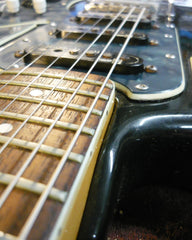Neck work on a Burns/Baldwin Bison
Share
We don't see a lot of these here in Australia but I've always been a big fan of them after staring at pictures of them in guitar books and mags when I was younger. Burns stuff always fascinated me as it was so ......... different. They had many very inventive and quite brilliant ideas for guitars that never caught on in a mainstream market but I still consider them one of the most influential manufacturers on what I do.


This one came in with a couple of issues like a cracked body in the neck pocket and someone had removed the zero fret and installed a nut ? I've actually done this job on several Burns guitars and I can't understand why someone would take out a zero fret ? I'm a HUGE fan of them and my favourite manufacturer, Mosrite ALWAYS used them. I think people look at them as being "cheap" because a lot of student import guitars used the zero fret to save on setting up the nut properly. I'm a fan of them because the string height is always perfect at the "nut end" and the open strings have the same "tone" as the fretted strings as there's no nut, ALL the strings are taking off from a fret. Great.

Anyway, I started with fixing the nut. I removed the old nut and looked around for a timber that matched the colour of the original fretbaord as close as possible. I keep old fretboards and offcuts from my fretboards (when I made guitars) around fore this very reason. They're always handy when repairing fretboards to cut pieces out of to fill worn, broken and cracked fretboards or for these sorts of repairs.

I didn't have one that matched perfectly but this piece looked good. It's actually a piece of Jarrah, which I used for most of my fretboards. The colour was close and it looked the best when laid next to the fretboard. With the old nut out it was just a matter of cutting a new piece of timber to inlay into the old slot. The original nut (or string guide) ran on the end of the fretboard like a Gibson so I was just filling the whole board and cutting a new slot for the zero fret to sit in.

With the piece of timber installed all that had to be done was clean it up and blend it in a bit. The colour match wasn't bad and I was going for functionality over a "proper restoration" as this was a player. The original zero fret had been on the front edge of the nut and after measuring to make sure (always measure) the slot needed to be cut for the fret.

To do this I paired away the binding as the frets on these are installed over the binding, not like a Gibson that has "nub ends" on each fret. To do this I heated the binding very carefully to make the glue soft and peeled away the binding with a cutting blade. With the binding out of the way I used my fretsaw to cut a new slot and then glued the binding back into place.

A new zero fret was installed as any other fret would be put in. Some people believe a zero fret needs to be bigger than the other frets to work but it's actually the same fret as the rest. Look at it like when you push the string down on the first fret, that becomes the take off point for the string. The zero fret is exactly the same. It's just resting on that fret rather than being pushed with you finger. The new fret was in.

It just needed trimming and cleaning up.

The whole fretboard was given a fret dress and everything looked good. Well ..........

Burns do their neck pockets like the cheaper Japanese guitars of the 60's with the body wrapping up around the side of the neck to help stabilize the joint. I don't mind this technique when it's done properly, but again, people look at it as being "cheap" because of these import guitars. With a nice fit between neck and body it can add some stability with a bolt on neck. Unfortunately, this one had cracked right through the body and one "support" and needed to be repaired to fix tuning issues.

This is a pretty simple jog as long as there's not too much dirt and grime in the crack. Simply work glue into the crack and clamp. I did the body crack first to add some stability to the whole area and then repaired the raised support in much the same way. Making sure not to apply too much pressure to the piece as it would snap off easily being such a thin piece of (relatively speaking) soft wood. With all that glue dry and some paint work cleaned up, the neck was put back on. Perfect.


I did a clean up of the electronics which were original and while still working, were scratchy. It's all quality parts and wiring and the hand assembled nature of these guitars is evident throughout. All it needed was a new output jack which was replaced with the original brand and type (Cliff jack) and all was well.


It played great. It sounded great and it looked GREAT. For more pics, check HERE.















